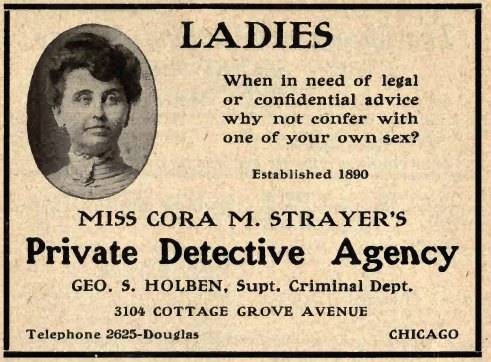Here Is the 1900’s Chicago Detective Someone Needs to Make a Movie About: Cora Strayer
Clever Girl

Those of us who are unnaturally super-duper into the NBC show Who Do You Think You Are? (returns tonight at 8:00!) and secretly dream of winning free memberships for Ancestry.com will appreciate the work that went into this.
Born in 1869, Strayer marries at 16, but is widowed a few years later (possibly in 1894). Apparently, she gives birth to two children, but neither live past childhood. After that, she is found under an address listing in 1898 with her occupation cited as “Clerk.”
The first time she is listed as a detective, however, comes in 1902. It looks like she’s an associate at a bigger agency. The address, oddly enough, is an apartment above a tavern that was “consistently raided by the cops.” Strayer is profiled by the Chicago Tribune in August 1903, giving her even more legitimacy as a detective. Finally, she is pictured in her very own ad in 1905, with a George S. Holben listed as a “Supt. of the Criminal Department.” Probably the superintendent. But Holben was soon involved in a robbery that involved $750 worth of diamonds and the drugging of his landlady. He was not prosecuted. Hmmm … did Strayer have any knowledge of this?
In 1907, a headline appears in the newspaper above a story about the murder of a Dr. B. F. Harris: “Woman Sleuth ‘Uses Wine.'” That year, someone named “Mrs. Campbell” had hired Strayer to get to the bottom of some letters being sent by a “Mrs. Harris,” who is appearing to be writing fake letters to Dr. Harris, describing a fake affair with Mrs. Campbell.
Cora takes Mrs. Harris on a trip to Milwaukee, gets her drunk on $150 of fine wines, and steals the letters when she is passed out. Turns out Mrs. Campbell and Dr. Harris actually were having an affair and he performed an abortion on her. Mr. Campbell eventually killed Dr. Harris.
From 1905 to 1912, Reda says that ads for Strayer’s private detective agency appear consistently, but the one with the direct appeal to women (the one pictured above with the line “Ladies, when in need of legal or confidential advice, why not confer with one of your own sex?”), makes its first appearance in 1908. (Though he finds the claim that Strayer has been practicing law since 1890 to be dubious.) The following year, Strayer is featured in an article entitled “Business Women Who Have Made a Success Bossing Men.”
In 1910, George Holben is shot and killed, but his name remains on the agency’s ads until 1912, when they finally disappear. But here’s what led up to that:
George Holben is shot and killed by Stephen Ayers, a 33 year old disgruntled ex-employee of the agency. Ayers claims that he met Cora in Seattle over the summer and that they traveled along the west coast with each other. He says that Cora invited him to Chicago with with promises of a job and marriage, but that she was being held hostage by Holben. Cora denies any love affair and says that she ordered Ayers fired due to unreliability. The murder even gets coverage in Los Angeles. Ayers is later sentenced to 15 years, and in 1913 he escapes from prison, but was caught two days later.
When she is 42, Strayer marries a man named Robert L. Fortune, who is 24 at the time. Cora, you little cougar, you! Fortune, however, dies in 1913, and it looks like his medical bills leave his widow $9,000 in debt. She files for bankruptcy.
But wait — that is not the end of Cora Strayer Murray Fortune. In 1914, she forms the First Volunteer Women’s Cavalry Regiment to fight the Border War with Mexico. She is featured in another newspaper article, and provides the following quote:
“Do you want to wait until all the men are killed to do your duty, sisters? A woman that would stand and let a man do all the fighting and suffering for his country is not a soldier. She belongs in the effete ranks of those who hurry abroad when the trouble starts. Pooh! She is not even worthy of the ballot.”
Two hundred women end up joining the regiment. F*ck yeah, they did.
After that, she still continued to investigate and work with the police, including on a case that ended in a car chase through Chicago.
The last ad Reda finds is from 1930, just the most simple listing for Strayer’s services. In 1932, after a seriously accomplished life, Cora Strayer passes away at the age of 63.
Someone — anyone — no, not anyone. Someone who is awesome at their job: Make a movie or a TV show based on Cora Strayer. Allison Janney could play her. Allison Janney could play her.
(Paul Reda via Boing Boing)
Have a tip we should know? tips@themarysue.com